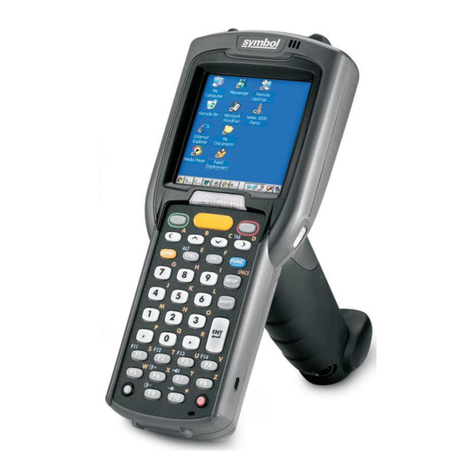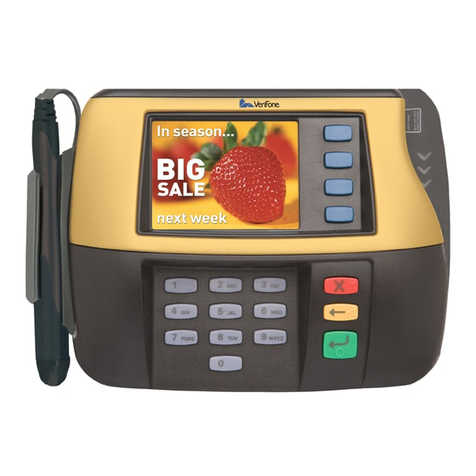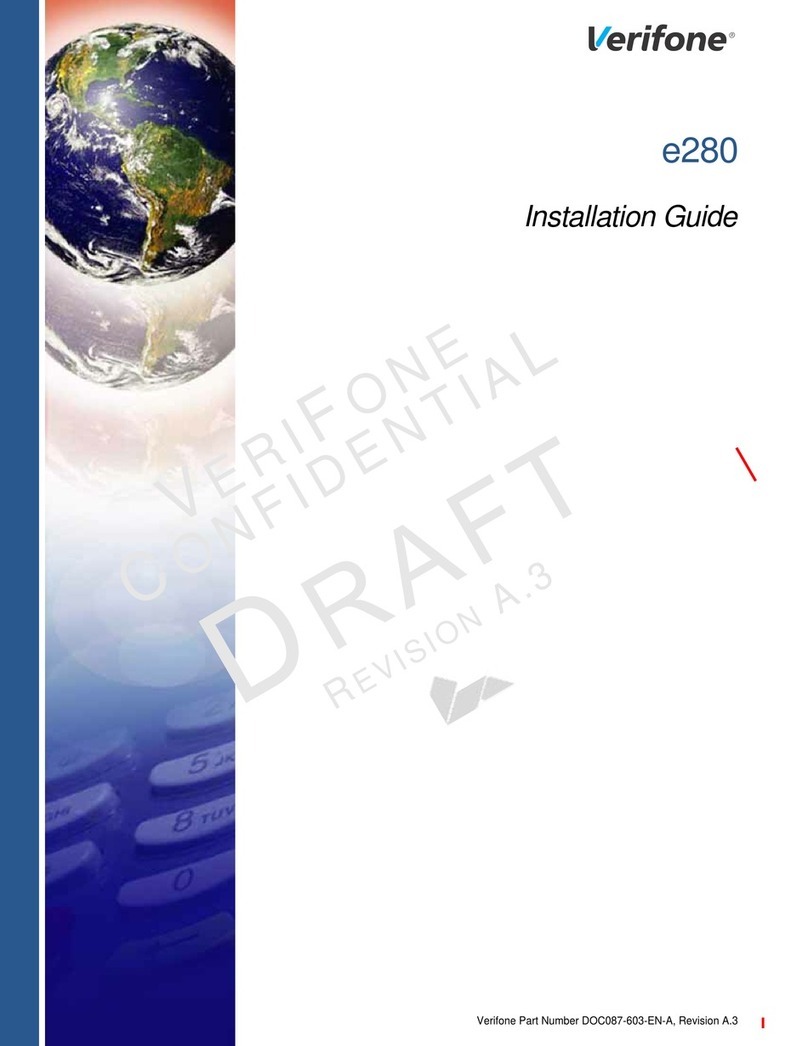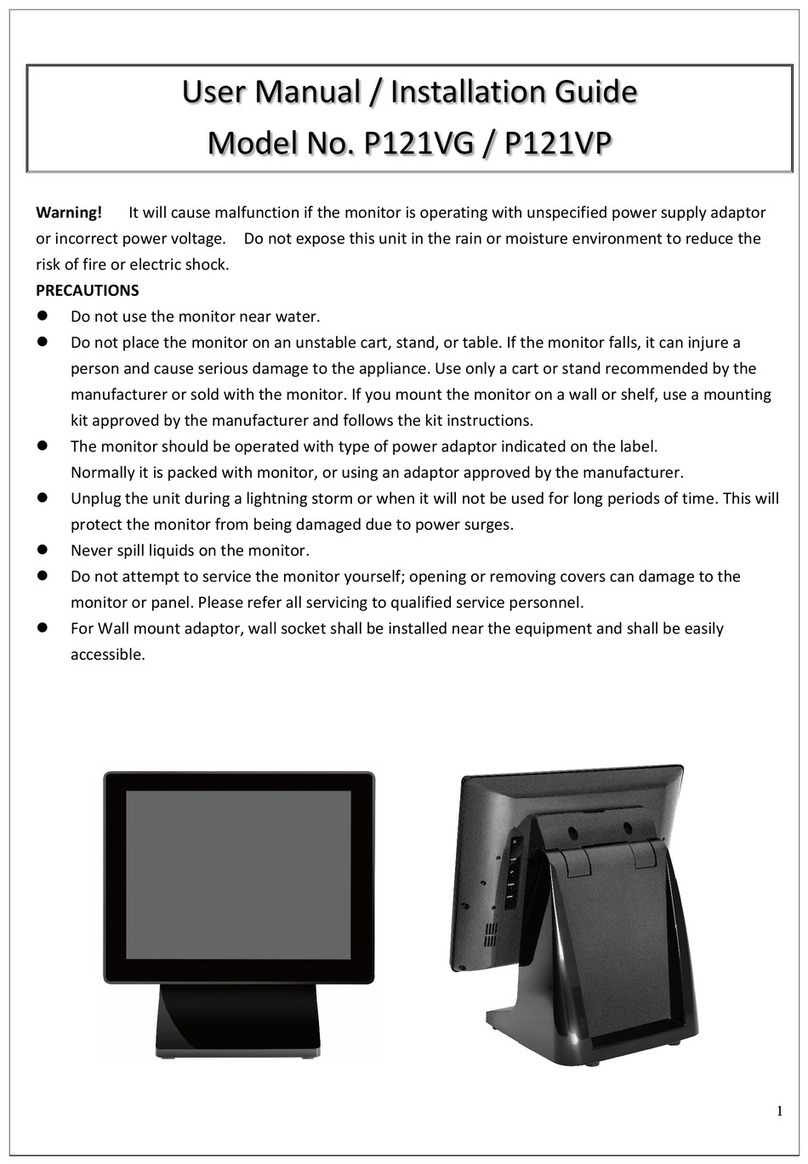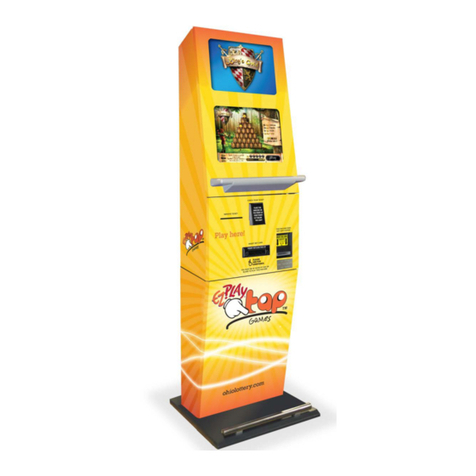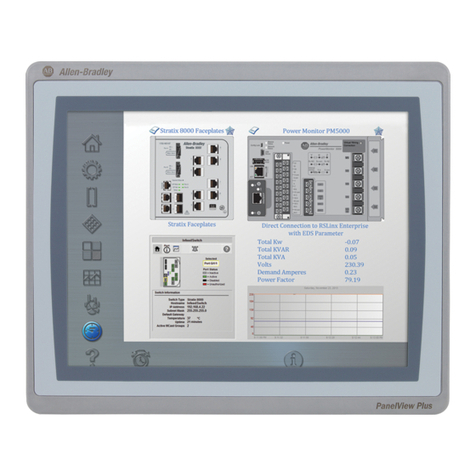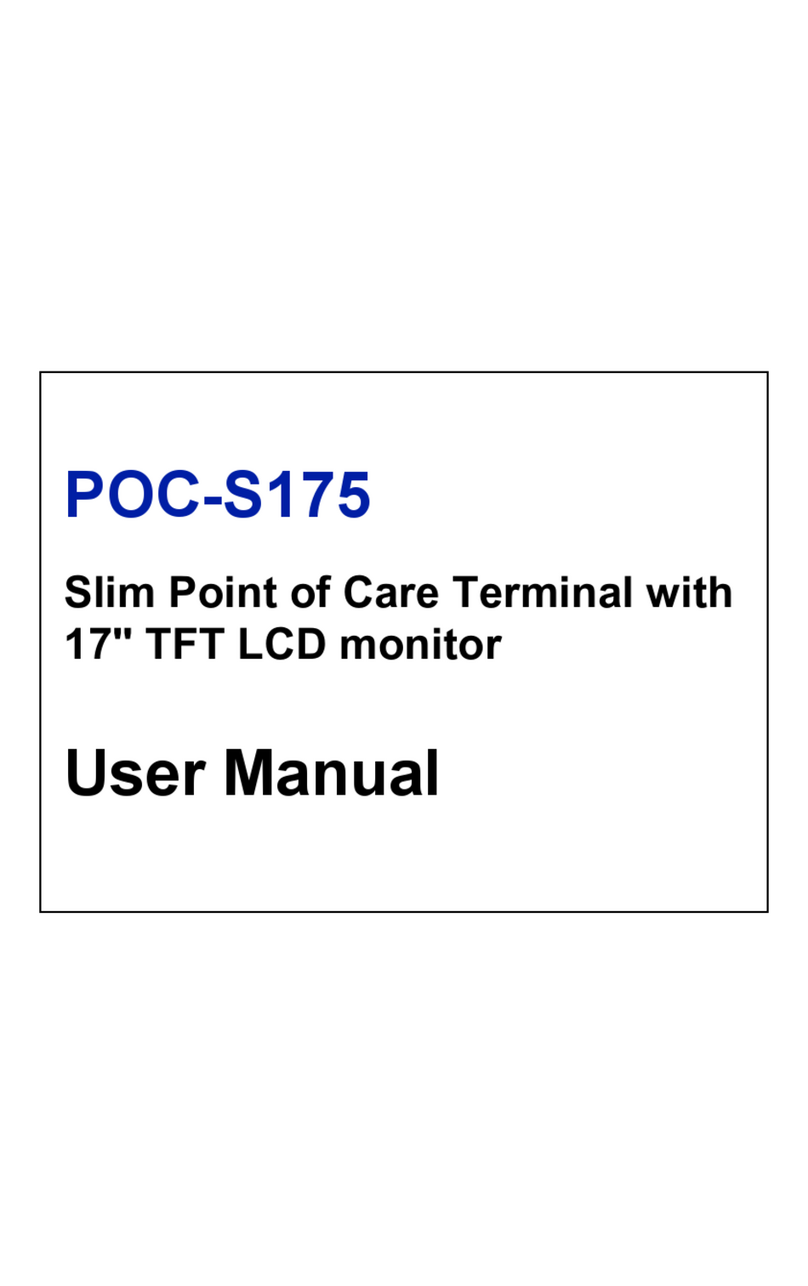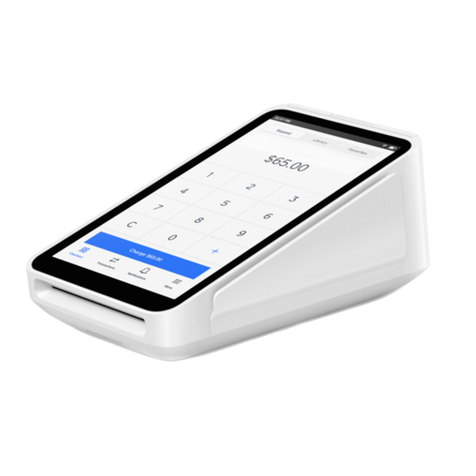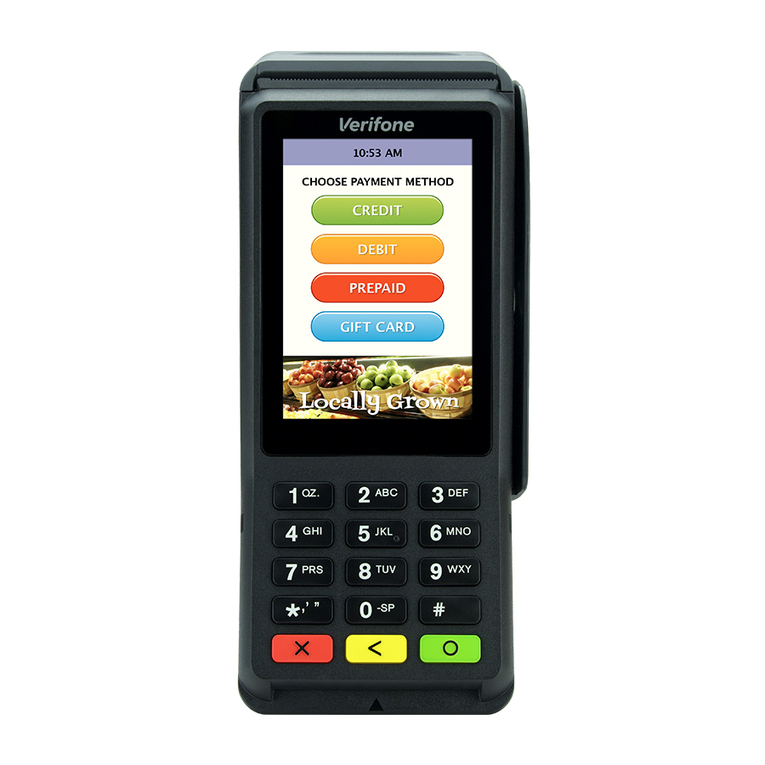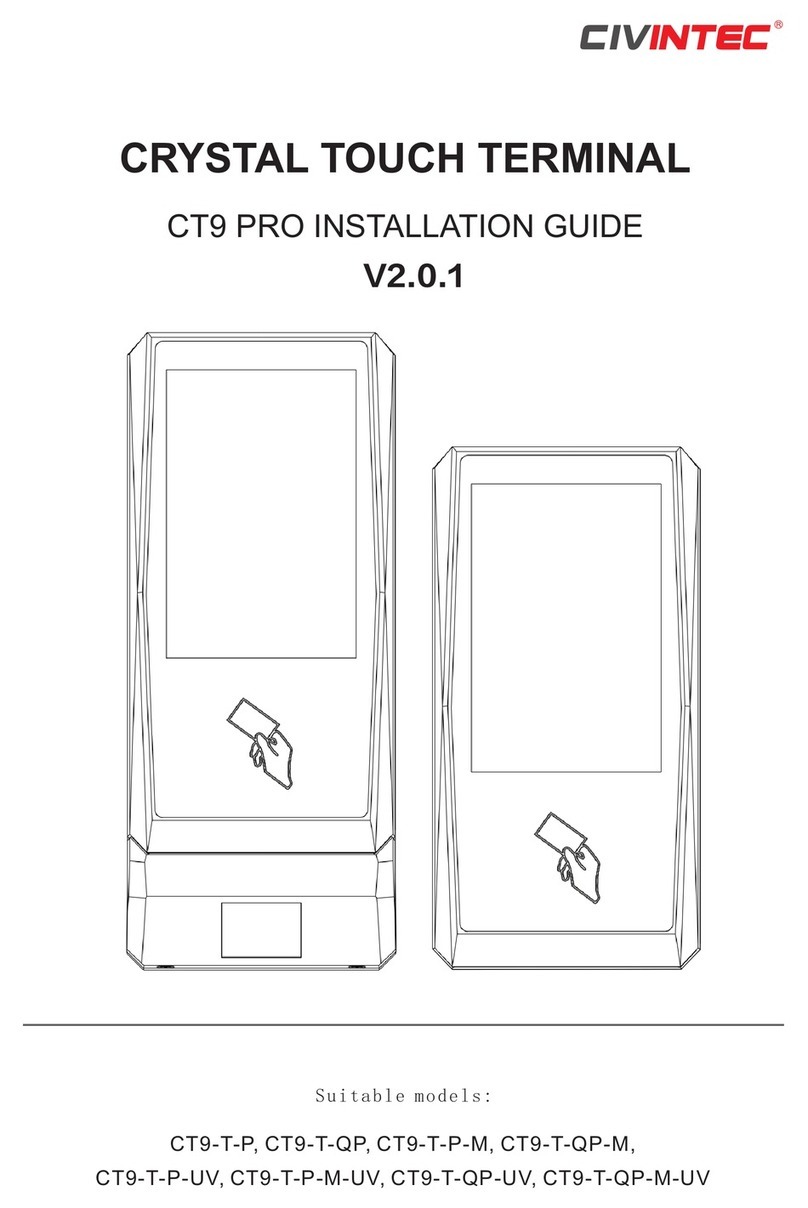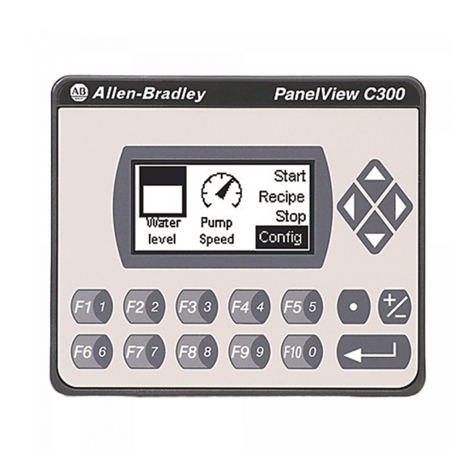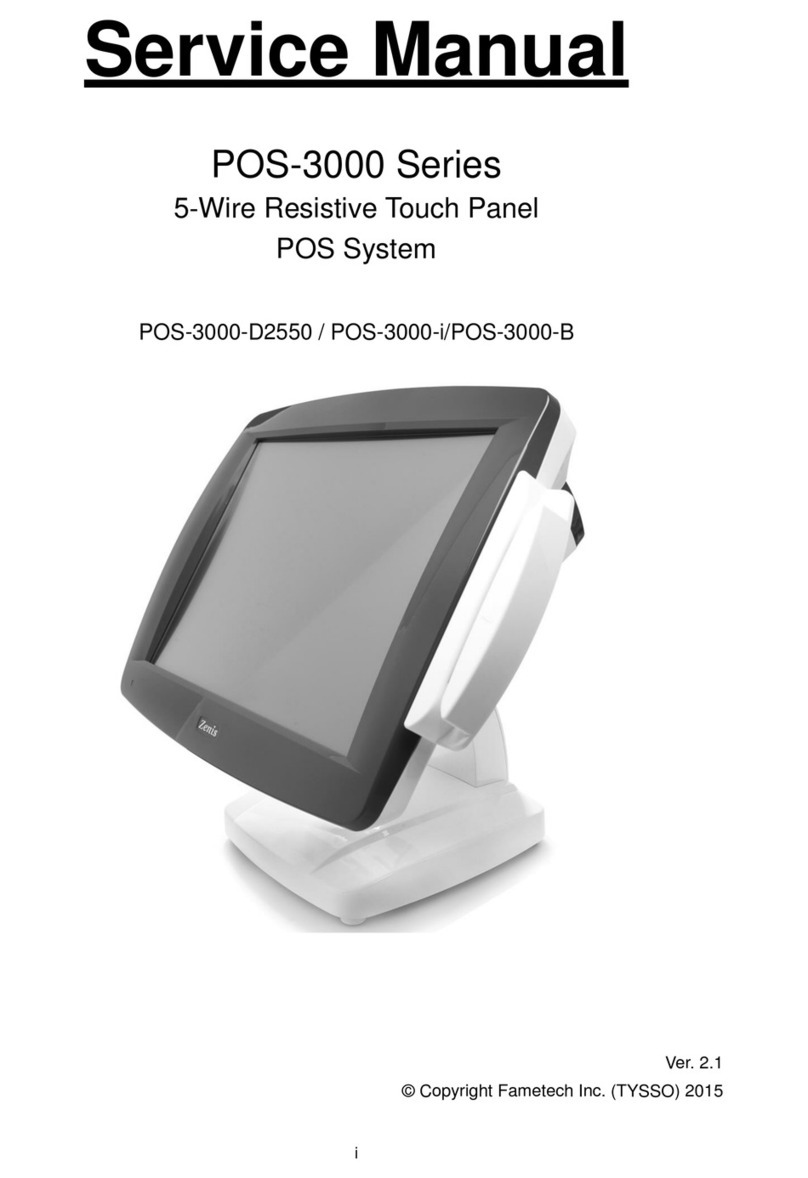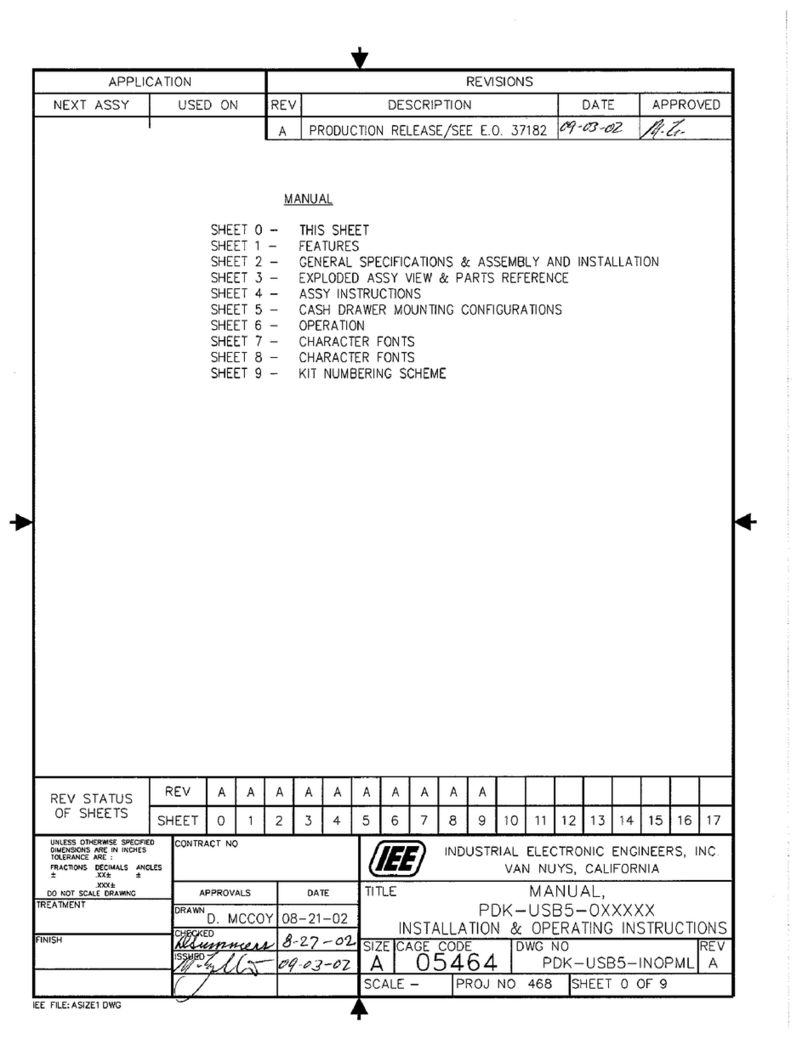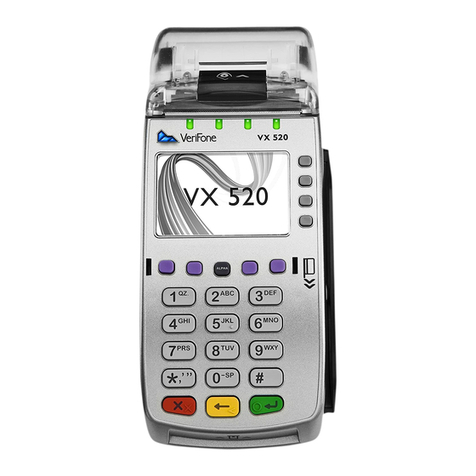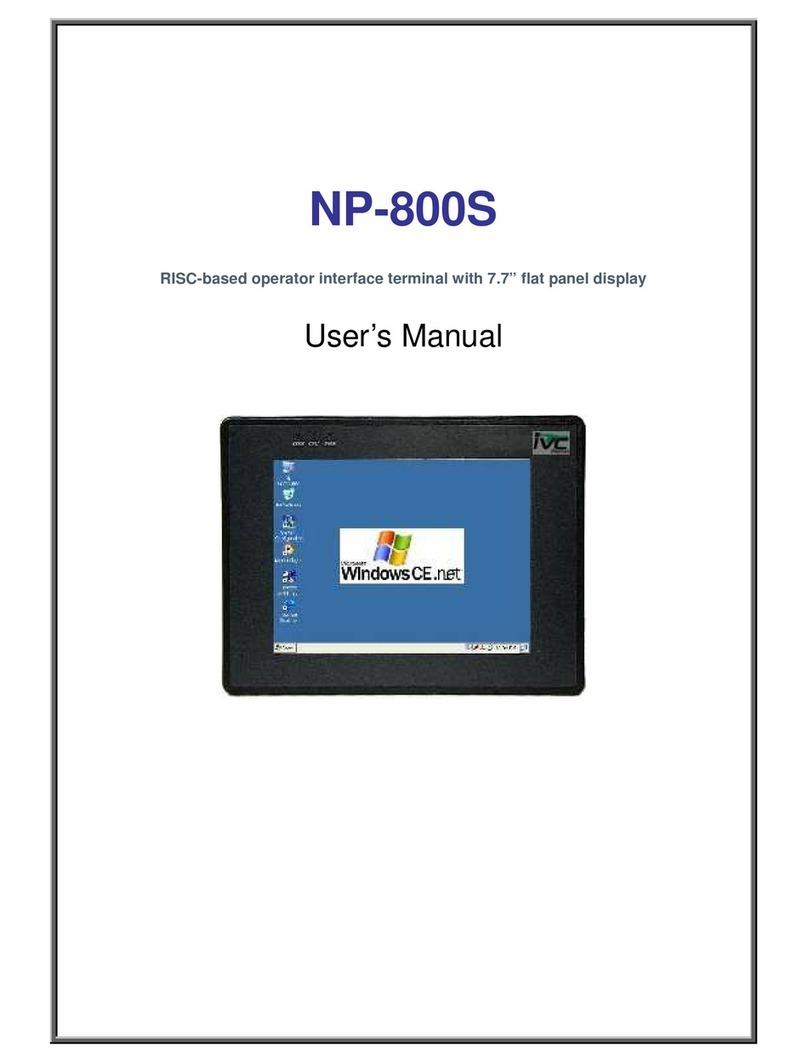Jetter JetViewMobile 205 User manual

User Manual
JetViewMobile 205
ISOBUS terminal
We automate your success.
60887527_00

This document has been compiled by Jetter AG with due diligence based on the state of the art as
known to them. Any revisions and technical advancements of our products are not automatically made
available in a revised document. Jetter AG shall not be liable for any errors either in form or content, or
for any missing updates, as well as for any damage or detriment resulting from such failure.
Jetter AG
Graeterstrasse 2
71642 Ludwigsburg Germany
Germany
Phone
Switchboard +49 7141 2550-0
Sales +49 7141 2550-663
Technical hotline +49 7141 2550-444
E-mail
Technical hotline [email protected]
Sales [email protected]
www.jetter.de
Translation of the german original User Manual
Revision 1.00
Date of issue 4/28/2023

Jetter AG Table of contents
User Manual – JetViewMobile 205 iii
Table of contents
1 Introduction ....................................................................................................................................... 5
1.1 Information on this document .................................................................................................. 5
1.2 Typographical conventions...................................................................................................... 5
1.3 Legal notices............................................................................................................................ 6
2 Safety................................................................................................................................................ 7
2.1 General Information................................................................................................................. 7
2.2 Purpose ................................................................................................................................... 7
2.2.1 Intended use................................................................................................................ 7
2.2.2 Usage other than intended .......................................................................................... 7
2.3 Warnings used in this document.............................................................................................. 8
3 Product Description........................................................................................................................... 9
3.1 Design...................................................................................................................................... 9
3.2 Product Features ..................................................................................................................... 10
3.3 Nameplate ............................................................................................................................... 11
3.4 Scope of delivery ..................................................................................................................... 11
4 Technical data................................................................................................................................... 12
4.1 Dimensions .............................................................................................................................. 12
4.2 Display ..................................................................................................................................... 12
4.3 Pushbuttons............................................................................................................................. 13
4.4 Processor Kernel ..................................................................................................................... 13
4.5 Mechanical specifications........................................................................................................ 13
4.6 Environmental conditions......................................................................................................... 13
4.7 Electrical properties ................................................................................................................. 14
4.8 EMC values ............................................................................................................................. 14
4.9 Ports and interfaces................................................................................................................. 15
4.9.1 ISOBUS interface ........................................................................................................ 15
4.9.2 USB interface .............................................................................................................. 15
4.10 Inputs/outputs according to ISO11786:1995 ........................................................................... 16
4.11 Acoustic signal generator ........................................................................................................ 16
4.12 Real-time clock ........................................................................................................................ 16
5 Mechanical installation...................................................................................................................... 17
5.1 Allowed mounting orientations................................................................................................. 18
6 Electrical connection ......................................................................................................................... 19
6.1 8-pin M12 connector (male)..................................................................................................... 19

Jetter AG Table of contents
User Manual – JetViewMobile 205 iv
7 Firmware and system menu.............................................................................................................. 20
7.1 Creating an EDC file................................................................................................................ 20
7.2 Description of the IOP file of the system menu........................................................................ 20
7.3 Updating the firmware and system menu via USB .................................................................. 21
7.4 Updating the firmware and system menu via CAN bus ........................................................... 22
8 Programming .................................................................................................................................... 23
8.1 Properties of the system menu................................................................................................ 23
8.1.1 Reserved Object IDs ................................................................................................... 23
8.1.2 Physical keys............................................................................................................... 28
8.1.3 Key Codes ................................................................................................................... 28
8.2 Character set types of the system menu ................................................................................. 30
8.3 Language selection in the system menu ................................................................................. 30
8.4 Programming examples........................................................................................................... 31
8.4.1 Programming example for numeric editor ................................................................... 31
8.4.2 Programming example for list editor............................................................................ 32
8.4.3 Programming example for string editor ....................................................................... 32
8.4.4 Programming example for multiple keyboards ............................................................ 33
8.4.5 Programming example for error messages ................................................................. 34
8.5 Defining the date format .......................................................................................................... 34
9 Maintenance ..................................................................................................................................... 36
9.1 Repairs .................................................................................................................................... 36
9.2 Return and disposal................................................................................................................. 36
9.3 Storage and shipment.............................................................................................................. 37
10 Service .............................................................................................................................................. 38
10.1 Customer service..................................................................................................................... 38
11 Spare parts and accessories ............................................................................................................ 39
11.1 Accessories ............................................................................................................................. 39

Jetter AG Introduction | 1
User Manual – JetViewMobile 205 5
1 Introduction
1.1 Information on this document
This document forms an integral part of the product and must be read and under-
stood prior to using it. It contains important and safety-related information for the
proper use of the product as intended.
Purpose of the
Document This document describes rules for the design of the system menu in ISOBUS op-
erating devices of Jetter AG.
It does not describe all the functions and operation of the virtual ISOBUS termi-
nal.
Target groups This document is intended for specialists with appropriate qualifications.
Only competent and trained personnel is allowed to put this device into operation.
During the whole product life cycle, safe handling and operation of the device
must be ensured. In the case of missing or inadequate technical knowledge or
knowledge of this document any liability is excluded.
Availability of
information Make sure this document is kept at the ready in the vicinity of the product
throughout its service life.
For information on new revisions of this document, visit the download area on our
website. This document is not subject to any updating service.
Start | Jetter - We automate your success.
For further information refer to the following information products:
■Application-oriented manuals
Cross-product documentation
■Version updates
Information about new versions of software products or of the operating sys-
tem of your device
1.2 Typographical conventions
This manual uses different typographical effects to support you in finding and
classifying information. Below, there is an example of a step-by-step instruction:
üThis symbol indicates requirements which have to be met before executing
the following action.
►This sign or a numbering at the beginning of a paragraph marks an action in-
struction that must be executed by the user. Execute the instructions one af-
ter the other.
ðThe target after a list of instructions indicates reactions to, or results of these
actions.
INFO Further information and practical tips
In the info box you will find helpful information and practical
tips about your product.

Jetter AG Introduction | 1
User Manual – JetViewMobile 205 6
1.3 Legal notices
The firmware and tools used by the device use software products or components
of the third-party providers named below.
Licenses of third-
party providers Product Licensor Link to the license document License type
FSF lib Free Software
Foundation
https://www.fsf.org/licensing GPLv3
CMSYS ARM Limited ARM contract reference LEC-
PRE-00489n-V3.0
Open Source
ST lib ST Microelec-
tronics
http://www.st.com/software_li-
cense_agreement_liberty_v2
Free for con-
trollers belong-
ing to ST
Python Python Soft-
ware Founda-
tion (PSF)
https://docs.python.org/3/li-
cense.html
GPL-compati-
ble
srec_cat Peter Miller http://srecord.sourceforge.net GNU GPLv3
Tab.1: Licenses of third-party providers

Jetter AG Safety | 2
User Manual – JetViewMobile 205 7
2 Safety
2.1 General Information
When placed on the market, this product corresponds to the current state of sci-
ence and technology.
In addition to the operating instructions, the laws, regulations and guidelines of
the country of operation or the EU apply to the operation of the product. The op-
erator is responsible for compliance with the relevant accident prevention regula-
tions and generally accepted safety rules.
RoHS 2 The device conforms to the EU directive 2011/65/EU (RoHS 2).
2.2 Purpose
2.2.1 Intended use
The device is intended for operation of ISOBUS applications for mobile work ma-
chines.
Operate the device only in accordance with the intended conditions of use, and
within the limits set forth in the technical specifications.
Intended use of the product includes its operation in accordance with this man-
ual.
2.2.2 Usage other than intended
This device must not be used in technical systems which to a high degree have
to be fail-safe.
Machinery Directive This device is no safety-related part as per Machinery Directive 2006/42/EC, and
must, therefore, not be used for safety-relevant applications. This device is NOT
intended for the purpose of personal safety, and must, therefore, not be used to
protect persons.

Jetter AG Safety | 2
User Manual – JetViewMobile 205 8
2.3 Warnings used in this document
DANGER
High risk
Indicates an imminently hazardous situation which, if not
avoided, will result in death or serious injury.
WARNING
Medium risk
Indicates a potentially hazardous situation which, if not
avoided, could result in death or serious injury.
CAUTION
Low risk
Indicates a hazardous situation which, if not avoided, could
result in minor or moderate injury.
NOTICE
Material damage
Indicates a situation which, if not avoided, could result in mal-
functions or material damage.

Jetter AG Product Description | 3
User Manual – JetViewMobile 205 9
3 Product Description
The JVM-205 control unit is an ISOBUS Virtual Terminal that features intuitive
operation. Due to the ISOBUS-UT functionality, it works together with ISOBUS
controllers. Communication is via the ISOBUS protocol.
Supported firmware This document refers to firmware version 2.0.0.84 and higher.
3.1 Design
Front
123456
7
8
Fig.1: Front of the HMI
1 On/Off key
2 ISB key
3 Home key
4 Navigation keys
5 OK key
6 Memory keys
7 Function keys
8 TFT-Touchscreen

Jetter AG Product Description | 3
User Manual – JetViewMobile 205 10
Rear
1
2
3
4
5
Fig.2: Rear of the HMI
1 Female thread for RAM mount holder
2 M12 male connector, 8-pin
3 Nameplate
4 Housing screw connection
5 Speakers
3.2 Product Features
■Display: 4.3" touchscreen, high-resolution
■Input: 11 user-programmable function keys (soft keys F1…F8, ISB; M1,
M2);
6 permanently assigned hard keys (On/Off, Home, ESC, Navigation, OK)
■1 digital input for the ignition signal
■Real-time clock (RTC) with battery backup (optional)
■ISOBUS-UT function
■16-MB flash memory
■Update of the operating system and system menu via USB
■Adaptable system menu

Jetter AG Product Description | 3
User Manual – JetViewMobile 205 11
3.3 Nameplate
1 2
3
4
5
6
7
Fig.3: Nameplate
1 Manufacturer logo
2 Barcode
3 Serial number
4 Certification mark
5 Hardware revision
6 Part number
7 Product type
3.4 Scope of delivery
Scope of delivery Item number Quantity
JVM-205 10002136 1

Jetter AG Technical data | 4
User Manual – JetViewMobile 205 12
4 Technical data
This chapter contains electrical, mechanical data and operating data of the
JVM-205.
4.1 Dimensions
42.3
25.0
30.0
35.1
107
160
R6.5
100
65
30.4
28.9
36.3
80
60
M5x6
Fig.4: Dimension in mm
4.2 Display
Parameter Description
Type TFT screen with touch function
Resolution 480x272pixels
Screen diagonal 4.3"
Background lighting LED, typ. 600cd/m2 , dimmable
Tab.2: Technical data – display

Jetter AG Technical data | 4
User Manual – JetViewMobile 205 13
4.3 Pushbuttons
Parameter Description
Number of membrane
keys
16keys
Background lighting Dimmable
Adjustable between 0%…100%
Typical service life 1,000,000 activations
Tab.3: Technical data – keys
4.4 Processor Kernel
Parameter Description
CPU STM32H7
FLASH 16MB
Tab.4: Technical data – computer core
4.5 Mechanical specifications
Parameter Description Standards
Weight 800 g
Enclosure specifications
Material Plastic
Vibration strength 10Hz…150Hz, 6h ISO16750-3
Shock resistance
Type of shock Half-sine wave ISO16750-3
Intensity and duration 50g for 18ms
Number and direction 10shocks in all 3directions of the spatial axes
Tab.5: Technical data – mechanical properties
4.6 Environmental conditions
Parameter Description Standards
Operating temperature -20°C…+70°C ISO16750-4
Climatic conditions Humid heat
Storage temperature -30°C…+70°C ISO16750-4
DINEN60068-2-1
DINEN60068-2-2
Relative humidity 5%…95%
Degree of protection With mating plug: IP65;
Without mating plug: IP20
Tab.6: Technical data – environmental conditions

Jetter AG Technical data | 4
User Manual – JetViewMobile 205 14
4.7 Electrical properties
Power supply T_ECU Parameter Description
Nominal voltage DC8.5V…18V
Permissible voltage
range VBAT_ECU
DC8V...18V
Maximum current
consumption
2A
Typical logic current con-
sumption (VBAT_ECU)
320mA at DC12V
Power consumption Approx 3W
Integrated protective
functions
Reverse polarity protection, overvoltage, short
voltage pulses
Tab.7: Technical data – power supply VBAT_ECU
4.8 EMC values
The JVM-205 has CE approval in accordance with ENISO14982 for 12-V on-
board systems.
Pulses acc. to
ISO7637-2 Test pulse Values Function class
1 -450V C
2a +37V A
2b +20V C
3a -150V A
3b +150V A
4 Ua1: -12V/50ms
Ua2: -5V/500ms
B (24-V systems)
Tab.8: Pulses in accordance with ISO7637-2
Pulses acc. to
ISO16750-2
(12-V on-board
systems)
Test pulse Values Function class
5b Load Dump
70V/2Ω/350ms
C
Tab.9: Pulses in accordance with ISO16750-2 for 12-V on-board systems
Irradiation acc. to
ISO11452 Irradiation Function class
20MHz...2GHz 30V/m A
20MHz...2GHz 100V/m B
Tab.10: Irradiation in accordance with ISO11452

Jetter AG Technical data | 4
User Manual – JetViewMobile 205 15
Emitted radiation acc.
to CISPR25 Emitted radiation Limit values
Narrowband emission
30MHz...1000MHz
30MHz…75MHz=52…42dBµV/m
(logarithmically decreasing)
75MHz…400MHz=42…53dBµV/m
(logarithmically increasing)
400MHz…1000MHz=53dBµV/m (constant)
Wideband emission
30MHz...1000MHz
30MHz…75MHz=62…52dBµV/m
(logarithmically decreasing)
75 MHz…400MHz=52…63dBµV/m
(logarithmically increasing)
400 MHz…1000MHz=63dBµV/m (constant)
Tab.11: Emitted radiation acc. to CISPR 25
ESD acc. to
EN61000-4-2 Electrostatic discharge
(ESD)
Function class
Contact ±4kV A
Air ±8kV A
Tab.12: Electrostatic discharge (ESD) acc. to EN61000-4-2
4.9 Ports and interfaces
4.9.1 ISOBUS interface
Parameter Description
Baud rate 250 kBaud
Protocol ISOBUS
Terminating resistance Integrated
Cable specification CAN-compliant, twisted wire pairs, unshielded
Tab.13: Technical data – ISOBUS interface
4.9.2 USB interface
Parameter Description
Supply unit 5V, max. 500mA
Data rate USB1.1
Protocol USB-Host-Interface
Tab.14: Technical data – USB interface

Jetter AG Technical data | 4
User Manual – JetViewMobile 205 16
4.10 Inputs/outputs according to ISO11786:1995
Within the operating voltage range, all inputs are voltage-proof and overcurrent
protected.
Input/output for
ignition Parameter Description
Ignition input/output
Abbreviation IGN_KEY
Quantity 1
Input
Power supply 12V
Output
Max. output current 0.5A
Tab.15: Input/output for ignition
4.11 Acoustic signal generator
Category Description
Type Piezo
Volume >70dB With resonance
frequency and without
mechanical damping.
Volume control Turned off,
10%…100%
Controlled via PWM.
Frequency range 200Hz…4kHz
Tab.16: Technical data – acoustic signal generator
4.12 Real-time clock
Optional equipment.
Parameter Description
Battery type CR2032
Service life Approx. 10years from
production.
The service life of the battery
depends on the ambient condi-
tions and may therefore differ.
Tab.17: Technical data – real-time clock

Jetter AG Mechanical installation | 5
User Manual – JetViewMobile 205 17
5 Mechanical installation
NOTICE
Damages to material or functional impairment due to
welding
Welding on the chassis may damage the device material, or
impair device functions.
►Before you start welding, disconnect all connections be-
tween the device and the electric system of the vehicle.
►Protect the device from flying sparks and welding beads
(splatter).
►Do not touch the device with the welding electrode or
earth clamp.
NOTICE
Dirt and moisture can affect the electrical connections
►Protect unused pins using blanking plugs.
►Protect all electrical connections with appropriate single
wire seals.
►Clean the area around a connector prior to removing the
mating connector.
NOTICE
Compliance with degree of protection
The protection class of the device is only ensured if the M12
cable gland is tightened securely.

Jetter AG Mechanical installation | 5
User Manual – JetViewMobile 205 18
5.1 Allowed mounting orientations
The device has a RAM mount connection and can be installed in the driver's cab
with a suitable holder.
Fig.5: Permitted installation position with RAM mount holder

Jetter AG Electrical connection | 6
User Manual – JetViewMobile 205 19
6 Electrical connection
WARNING
Signal disruption due to incorrect CAN wiring
Unshielded or incorrectly twisted CAN lines may cause com-
munication faults. In the worst case, a malfunction of the de-
vice can lead to subsequent physical injury.
►Connect 120 Ω termination resistors to both ends of the
CAN bus.
NOTICE
Damages to material or functional impairment
Improper implementation of the wiring harness may cause
mechanical stress.
►Protect the cables from bending, twisting or chafing.
►Install strain reliefs for the connecting cables.
NOTICE
Surges resulting from missing protection or fusing
Surges may cause malfunctions or damage to the product.
►Protect the voltage inputs from surges according to the
requirements.
►Ensure that the device is handled in accordance with
ESD regulations.
6.1 8-pin M12 connector (male)
2
1
7
5
6
4
3
8
Fig.6: 8-pin M12 plug
1 Power supply term.30 (+12 V)
2 USB data transfer +
3 Ignition input/output (max. 0.5 A)
4 USB data transfer -
5 CAN-L
6 Power supply term. 31 (GND)
7 CAN-H
8 USB +5 V (USB_VBUS)
Tab.18: Pin assignment of the M12 plug
INFO To use the USB signal, the use of a cable T-piece is recom-
mended.

Jetter AG Firmware and system menu | 7
User Manual – JetViewMobile 205 20
7 Firmware and system menu
This section describes how to load the firmware and system menu into the control
unit. The following options are available:
■Via USB
■Via CAN bus
Both require special Accessories [}39].
7.1 Creating an EDC file
The EDC file contains all the information needed to update the firmware, includ-
ing the system menu.
The EDC file must be generated. Follow these steps:
1. Unpack the corresponding firmware package. This package is provided for
you by Jetter Support ([email protected]).
2. Run script
edc_make.bat
.
ð3files are generated, one for each of the available interfaces:
■
41434445.EDC
: Updating the firmware and system menu via USB
■
41434445_EDC_x_x_x_x_.hex
: Updating the firmware and system menu via
CAN bus
■
41434445_Emergency.hex
: Update firmware and system menu via RS232
(not supported).
7.2 Description of the IOP file of the system menu
Fig.7: Jetter software
ISO-Designer
The system menu is written by an IOP file that is usually created using ISO-De-
signer software from Jetter.
Running script
edc_make.bat
, which is included in the firmware package, links
the IOP file with the files of the firmware in an EDC file and transfers them to-
gether to the control unit (Creating an EDC file).
Structure of EDC file
– example
4544-4334;1.6.0.48;41434445; output file (EUID is hardware-
dependent)
4669-726d;1.6.0.48;small_HMI.hex; firmware
426f-6f74;1.0.0.2;bootloader_v2.hex; Bootloader
496f-7072;1.0.0.0;MyProject1.iop; customer-specific system
menu
4c5f-3f3f;0.0.0.8;system_menu_de.iop; system menu (addi-
tional language)
5069-6374;1.0.0.3;start_up.png; illustration on start screen
Where:
■Column1 (496f-7072) is the EUID that identifies the content of the system
menu.
It must not be changed!
■Column2 is the version number of the IOP file of the system menu; available
at runtime.
■Column3 (MyProject1.iop) is the name of the IOP file.
Adapt the content of this column to the name of your IOP file if necessary.
■Column4 is the comment field. It is not compiled.
Table of contents
